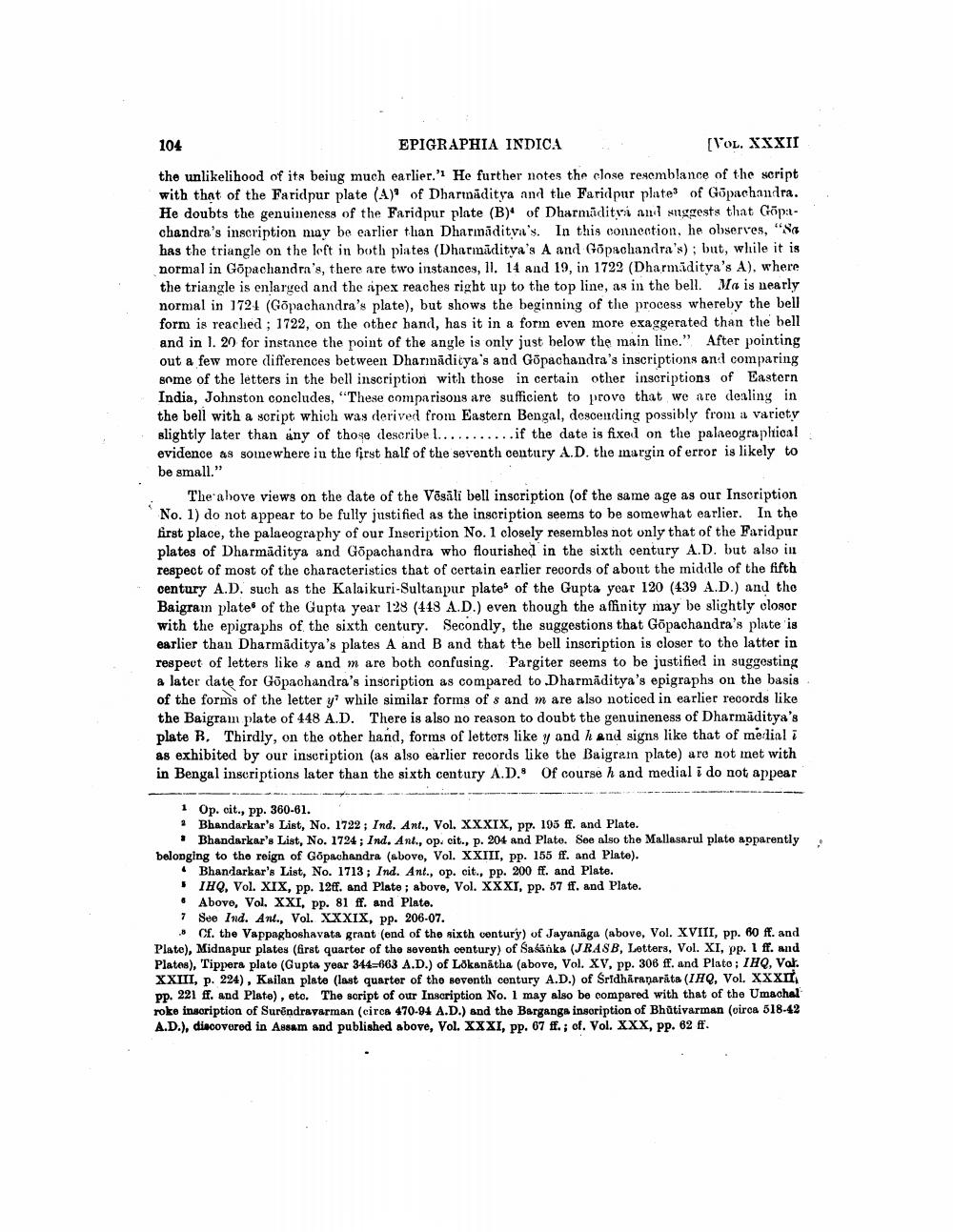________________
104
EPIGRAPHIA INDICA
[Vol. XXXII
the unlikelihood of its being much earlier.' He further notes the close resemblance of the script with that of the Faridpur plate (A)' of Dharmaditya and the Faridpur plate of Göpachandra. He doubts the genuineness of the Faridpur plate (B)' of Dharmāditya and suggests that Gõp:chandra's inscription may be earlier than Dharmaditya's. In this connection, he observes, "Sa has the triangle on the left in both plates (Dharmāditya's A and Gopachandra's); but, while it is normal in Göpachandra's, there are two instances, 11. 14 and 19, in 1722 (Dharmiditya's A), where the triangle is enlarged and the apex reaches right up to the top line, as in the bell. Ma is nearly normal in 1724 (Gopachandra's plate), but shows the beginning of the process whereby the bell form is reached ; 1722, on the other hand, has it in a form even more exaggerated than the hell and in l. 20 for instance the point of the angle is only just below the main line." After pointing out a few more differences between Dharmaditya's and Gopachandra's inscriptions and comparing some of the letters in the bell inscription with those in certain other inscriptions of Eastern India, Johnston concludes, "These comparisons are sufficient to prove that we are dealing in the bell with a soript which was derived from Eastern Bengal, descending possibly from a variety slightly later than any of those describe l...........if the date is fixeil on the palaeographical evidence as somewhere in the first half of the seventh century A.D. the margin of error is likely to be small."
The above views on the date of the Vēsāli bell inscription (of the same age as our Inscription No. 1) do not appear to be fully justified as the inscription seems to be somewhat earlier. In the first place, the palaeography of our Inscription No. 1 closely resembles not only that of the Faridpur plates of Dharmāditya and Gopachandra who flourished in the sixth century A.D. but also in respect of most of the characteristics that of certain earlier records of about the middle of the fifth century A.D. such as the Kalaikuri-Sultanpur plates of the Gupta year 120 (439 A.D.) and the Baigram plate of the Gupta year 128 (413 A.D.) even though the affinity may be slightly closor with the epigraphs of the sixth century. Secondly, the suggestions that Göpachandra's plate 'is earlier than Dharmāditya's plates A and B and that the bell inscription is closer to the latter in respect of letters likes and m are both confusing. Pargiter seems to be justified in suggesting a later date for Gopachandra's inscription as compared to Dharmāditya's epigraphs on the basis of the forms of the letter y' while similar forms of s and m are also noticed in earlier records like the Baigram plate of 448 A.D. There is also no reason to doubt the genuineness of Dharmāditya's plate B. Thirdly, on the other hand, forms of lettors like y and hand signs like that of merlial i as exhibited by our inscription (as also earlier records like the Baigrann plate) are not met with in Bengal inscriptions later than the sixth century A.D. Of course h and medial i do not appear
1 Op. cit., pp. 360-61. • Bhandarkar's List, No. 1722; Ind. Ant., Vol. XXXIX, pp. 195 ff. and Plate.
• Bhandarkar's List, No. 1724; Ind. Ant., op. cit., p. 204 and Plate. See also the Mallasarul plate apparently belonging to the reign of Gopachandra (above, Vol. XXIII, pp. 155 ff. and Plato).
Bhandarkar's List, No. 1713; Ind. Ant., op. cit., pp. 200 ff. and Plate. I IHQ, Vol. XIX, pp. 12ff. and Plate; above, Vol. XXXI, pp. 57 ff. and Plate. • Above, Vol. XXI, pp. 81 ff. and Plate. 7 See Ind. Ant., Vol. XXXIX, pp. 206-07.
Cf. the Vappaghoshavata grant (end of the sixth century) of Jayanaga (above, Vol. XVIII, pp. 80 ff. and Plato), Midnapur plates (first quarter of the seventh century) of Sasanka (JRASB, Letters, Vol. XI, pp. 1 ff. and Plates), Tippera plato (Gupta year 344-063 A.D.) of Lokanatha (above, Vol. XV. pp. 306 ff. and Plato; IHQ, Vol. XXIII, p. 224), Kailan plato (last quarter of tho seventh century A.D.) of Sridhiraparāta (IHQ, Vol. XXXI pp. 221 ff. and Plate), eto. The script of our Inscription No. 1 may also be compared with that of the Umachal roke inscription of Surendravarman (circa 470-94 A.D.) and the Barganga insoription of Bhativarman (circa 518-42 A.D.), discovered in Assam and published above, Vol. XXXI, pp. 67 f.; of. Vol. XXX, PP. 62 ff.




